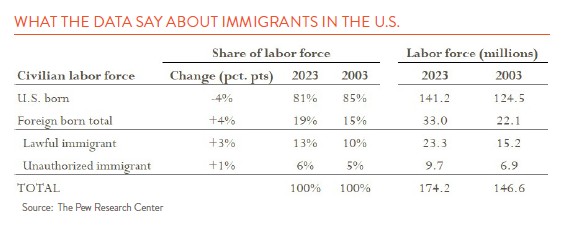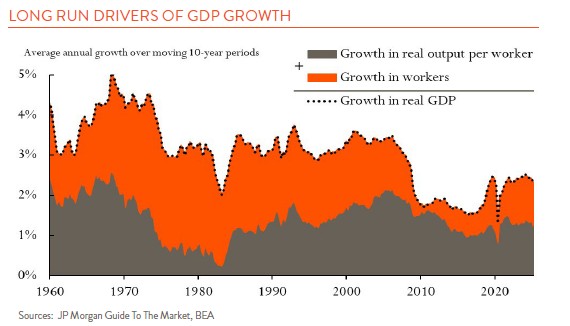Last month, we discussed America’s Total Fertility Rate (TFR), the average number of children a woman between the ages of 14 and 49 is expected to have over her lifetime. It’s been falling. After holding steady for some years at around 2.1, a rate which ensures a stable population, America’s TFR has fallen to 1.6. The Penn Wharton Budget Model expects this rate to stay steady over the next thirty years. If it does, deaths in America will exceed births by 2035 and total population could actually fall.
There is, however, another way population can grow – immigration – but as we know, this is a politically explosive issue. There are 52 million people living in America today who were born abroad, nearly 16% of the total population. This is the highest percentage of immigrants on record. Of the 52 million, 38 million are lawful immigrants, eight million have some legal protection (asylum seekers, etc.), and six million are unauthorized. As the table below shows, immigrants are an important part of the economy, accounting for nearly 20% of the total workforce.

Immigration in America has gone through a number of growth waves. Between 1840 and 1890, Northern Europeans dominated the immigrant lists. From around 1890 to the start of WWI, immigrants came mostly from Eastern Europe and Southern Europe. After immigration laws changed in 1965, Asians made up a large share of immigrant arrivals and more recently the majority of immigrants have come from Latin America. Some estimate that total immigration this year, legal and unauthorized, will come to a complete halt and be negative for the first time ever.
Immigration is vital today because, with the birth rate falling, it is the one way to increase the workforce. And a growing workforce is important because there are only two ways to grow an economy, one, by adding more workers and two, by making those workers more productive. In broad-brush terms, productivity has increased 2% per year in the U.S. over the long term and the workforce has grown 1%. This has allowed real output to grow 3% per year. When real output increases, so does our standard of living.
The Penn Wharton Budget Model forecasts that even after the current lockdown on all forms of immigration, long-term lawful immigration (‘green cards’) will continue to average what it has in the past, approximately one million people per year. This means immigration will offset some, but not all, of the slowdown in net births. Unless AI and other technologies can boost productivity more than currently expected, it is likely real growth in the U.S will average 2% in the future, versus 3% previously. Slower growth could negatively affect corporate profits which in turn could affect the stock market. A problem for investors.

Going forward, the country will not only continue to debate the level of immigration but also the make-up of the immigrant pool. Do we want only the ‘right’ kind of immigrants, the highly educated who will add immediately to economic growth and use few human services? But what about family reunification and asylum seekers, and most importantly, what about the sectors of the economy – construction, farming, landscaping, housekeeping, etc. – which rely on low cost labor for their existence? Immigration will continue to be a thorny issue.